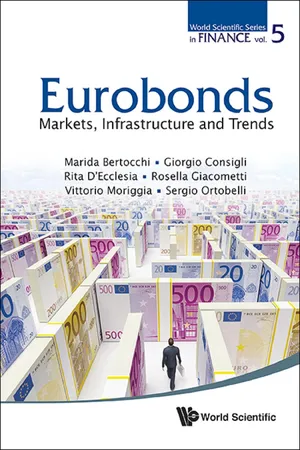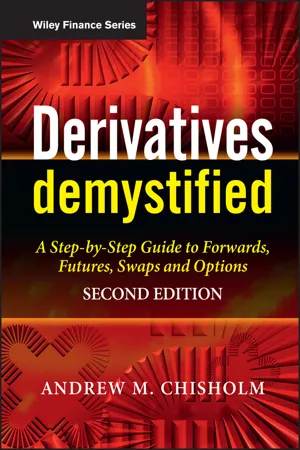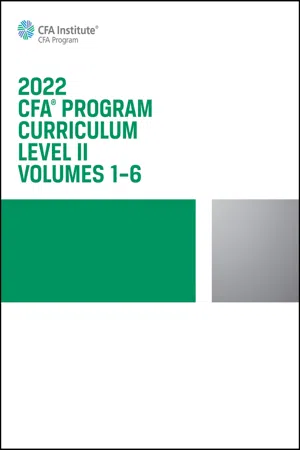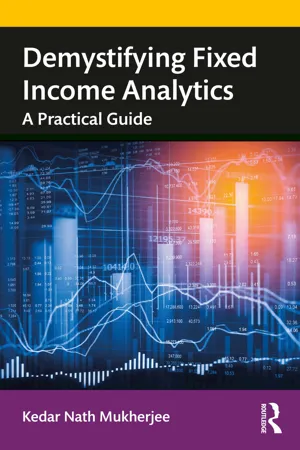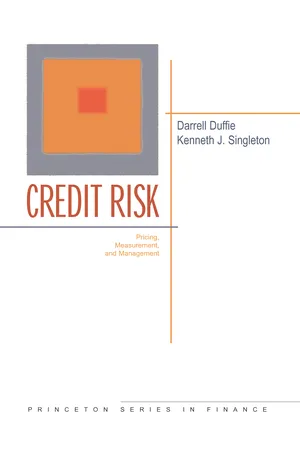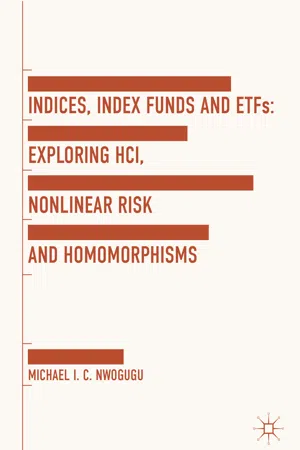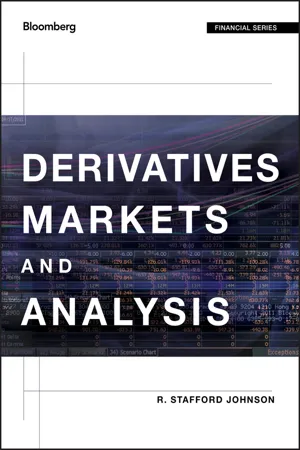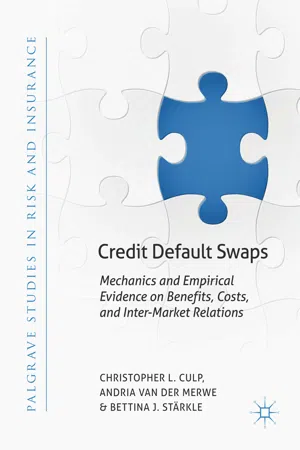Economics
Credit Default Swaps
Credit Default Swaps (CDS) are financial derivatives that allow investors to hedge against the risk of default on a loan or bond. In a CDS, the buyer makes periodic payments to the seller in exchange for protection against potential credit events. If a credit event occurs, the seller compensates the buyer for the loss incurred. CDS can also be used for speculative purposes.
Written by Perlego with AI-assistance
Related key terms
Related key terms
1 of 4
Related key terms
1 of 3
10 Key excerpts on "Credit Default Swaps"
- eBook - ePub
Euro Bonds: Markets, Infrastructure And Trends
Markets, Infrastructure and Trends
- Marida Bertocchi, Giorgio Consigli, Rita D'Ecclesia, Rosella Giacometti, Vittorio Moriggia, Sergio Ortobelli(Authors)
- 2013(Publication Date)
- WSPC(Publisher)
However, this quick rule of thumb must be used with caution. An increase in the CDS spread cannot be completely attributed to an increase in the Probability of Default, especially in a period of crisis. Recovery Rates are assumed to be fixed, but there is empirical evidence of a negative correlation between the Default Rate and the Recovery Rate over the cycle. In a period of financial market stress, with a higher liquidity risk premium and falling Recovery Rates, CDS spreads may also be affected by other risk premia, such as jump-to-default risk and systemic risk. The canonical example of jump-to-default risk is the Lehman Brothers’ default, i.e. the risk of a credit default occurring was so sudden that the market was not able to incorporate the increased default risk into the current spreads. Systemic risk, is the risk of the simultaneous failure of a number of institutions due to interconnections in the financial system.Credit Default Swaps are generally used for hedging purposes, in addition to their function of information disclosure. Assume an investor holds a portfolio of risky bonds. It is possible to shift and eliminate the credit risk by buying the protection implicit in the relevant CDSs. This might be more desirable than simply selling the security if the investor only wants to reduce the risk exposure and not completely eliminate it. If a bank has a loan protected by a credit derivative its risk exposure is reduced. Because Credit Default Swaps enable banks to lend at lower risk, these contracts increase liquidity in the credit market. Credit Default Swaps thus significantly expand companies’ access to capital from bank lending. In term of hedging, CDSs can be used to diversify the credit risk of a bond portfolio and to hedge the counterparty risk of dealers. As part of daily trading activities, dealers take unsecured exposure to other financial institutions which are the counterparties of their transactions. Part of this risk can be mitigated by CDSs.Fig. 8.3 Nominal amount outstandings.CDSs may also be used for speculation or arbitrage. In normal conditions speculators and arbitragers have a positive effect on the market since they increase the liquidity of the market and eliminate pricing inefficiencies.The European parliament voted in November 2011 to ban naked Credit Default Swaps on sovereign securities. This rule will make it impossible to buy CDSs for the sole purpose of speculating on a country’s default. Naked CDS instruments were prohibited in the Eurozone from December 1, 2011. Purchasing Italian CDS, for example, will now be possible only if the buyer already owns Italian government bonds or has invested in a sector which is highly dependent on the performance of these bonds, such as an Italian bank. - eBook - ePub
Derivatives Demystified
A Step-by-Step Guide to Forwards, Futures, Swaps and Options
- Andrew M. Chisholm(Author)
- 2011(Publication Date)
- Wiley(Publisher)
Repudiation/Moratorium. It renounces its debt obligations and refuses to pay.CREDIT DEFAULT SWAP APPLICATIONS
Perhaps the most obvious use of a CDS occurs when an investor or a commercial bank buys protection against losses on debt assets such as bonds and loans. In effect, the CDS provides a form of insurance, at the cost of paying the premium.It is important to be selective here. An investor that covers all the default risk on a portfolio of debt securities using CDS contracts will be left with a return close to that on Treasuries (in practice it will probably be rather less than this because of transaction costs).Credit Default Swaps are also invaluable for traders and hedge funds. It allows them to take a view on changes in the credit risk of borrowers without having to trade in physical debt securities. A standard CDS is an unfunded structure which means that, unlike buying an actual bond, an investor does not have to make an initial payment (although the investor may have to deposit collateral as a guarantee of good faith).Taking a View on Credit RiskA trader thinks that the creditworthiness of a corporation (the reference entity) is likely to deteriorate. The trader buys protection using a CDS and pays a premium of 1% p.a. If the credit risk on the corporation does increase the trader will then be able to sell protection on the same reference entity and earn a higher level of premium. Alternatively, if a credit event occurs, the trader can purchase the reference entity’s bonds cheaply in the market, deliver them against the CDS contract and receive their full par value.CDS contracts can have the additional advantage that they can be highly liquid at certain maturities. They also allow traders to take views on default risk over maturities that are not available with the underlying bonds.Finally, financial institutions such as insurance companies can earn additional income and also diversify their current activities by selling protection on CDS contracts. The danger is that losses can snowball if the level of defaults rises. The US insurance giant AIG Inc. had to be bailed out by the US government in September 2008 because of losses on CDS deals and other types of insurance written to protect banks against losses on loans. As discussed in Chapter 1, the US authorities decided to rescue AIG because of the systemic risk to the financial system if it failed to meet its obligations. - eBook - ePub
- (Author)
- 2021(Publication Date)
- Wiley(Publisher)
In addition, the CDS market has increased transparency and insight into the actual cost of credit risk. The higher relative liquidity and relative sophistication of CDS investors allow for more accurate price discovery and facilitate trading during liquidity events when the cash market for bonds becomes illiquid. While many of the applications listed above are beyond the scope of this reading, a basic understanding of this important fixed-income tool is necessary for all investment professionals.Let’s now define a credit default swap :A credit default swap is a derivative contract between two parties, a credit protection buyer and credit protection seller, in which the buyer makes a series of cash payments to the seller and receives a promise of compensation for credit losses resulting from a credit event in an underlying.In a CDS contract there are two counterparties, the credit protection buyer and the credit protection seller . The buyer agrees to make a series of periodic payments to the seller over the life of the contract (which are determined and fixed at contract initiation) and receives in return a promise that if default occurs, the protection seller will compensate the protection buyer. If default occurs, the periodic payments made by the protection buyer to the protection seller terminate. Exhibit 1 shows the structure of payment flows.Exhibit 1. Payment Structure of a CDSCredit Default Swaps are somewhat similar to put options. Put options effectively enable the option holder to sell (put) the underlying security to the option seller if the underlying performs poorly relative to the exercise price. Similarly, in the event of a credit event on the underlying security, the buyer of credit protection receives a payment from the credit protection seller equal to the par or notional value of the security less the expected recovery value. If the credit quality of the underlying deteriorates but there is no outright credit event, the credit protection buyer is compensated only if the contract is unwound. How that compensation occurs and how much protection it provides are some points we will discuss. - eBook - ePub
Demystifying Fixed Income Analytics
A Practical Guide
- Kedar Nath Mukherjee(Author)
- 2020(Publication Date)
- Routledge India(Publisher)
12 Credit Default SwapsKey learning outcomes
At the end of this chapter, the readers are expected to be familiar with:- Meaning and history of Credit Default Swaps, especially in light of 2008 US subprime crisis.
- Different types of Credit Default Swaps, with special reference to emerging markets.
- Important features of Credit Default Swaps, in line with RBI guidelines on CDS.
- Current scope of CDS in India and its future challenges.
Meaning and definition of credit derivativesCredit Derivatives are financial instruments designed to transfer the credit risk from one counterparty to another. In other words, a credit derivative is a Privately Negotiated contract the value of which is derived from the credit risk of a bond, a bank loan, or any other instrument with an exposure to credit risk. Credit derivatives can have the form of forwards, swaps, and options, which may be embedded in financial assets like bonds or loans or other investments with a credit risk exposure. Therefore, credit derivatives, on the one hand, allow investors or creditors to eliminate or reduce credit risk involved in their investment, and allow the counterparty to make some profit and leverage their position by assuming the credit risk in their own books of accounts. On the other hand, credit derivatives can be defined as arrangements that allow one counterparty (Protection Buyer) to transfer, in exchange of a certain price called Premium, the defined credit risk (full or in part), computed with reference to a notional value, of a reference asset(s), with or without its actual ownership, to another counterparty or counterparties (Protection Seller).There are different basic and complex or synthetic derivatives products or instruments used to mitigate the credit risk that a person or entity carries in their books of accounts. Broadly, credit derivative instruments are classified into four categories: Credit Default Swaps (CDS), total rate of return swaps (TRORS), credit spread products, and different synthetic structures. Again, credit spread products include credit spread forward/futures, credit spread options, credit spread swaps, etc. Similarly, credit link notes (CLN), collarized debt obligations (CDOs), etc. are some of the examples of synthetic credit derivatives instruments. All the above products may be simple in nature, or they may have a complex structure based on the type of the products. Apart from having a common purpose of hedging against credit risk exposure, different credit derivative products have some identical features that can differentiate one product from the other. - eBook - ePub
- Frank J. Fabozzi, Frank J. Fabozzi(Authors)
- 2012(Publication Date)
- Wiley(Publisher)
Credit Default Swap Valuation REN-RAW CHEN, PhD Professor of Finance, Graduate School of Business, Fordham University FRANK J. FABOZZI, PhD, CFA, CPA Professor of Finance, EDHEC Business School DOMINIC O’KANE, PhD Affiliated Professor of Finance, EDHEC Business School, Nice, France Abstract: Credit Default Swaps are the most popular of all the credit derivative contracts traded. Their purpose is to provide financial protection against losses incurred following a credit event of a corporate or sovereign reference entity. Replication arguments attempting to link Credit Default Swaps to the price of the underlying credits are generally used by the market as a first estimate for determining the price at which a credit default swap should trade. The replication argument, however, is dependent on the existence of same maturity and same seniority floating rate bonds. Even if such securities do exist, contractual differences between CDS and bonds can weaken the replication relationship. Over the past decade, the increased liquidity of the CDS market has meant that in some cases, it, and not the bond market, is the place where credit price discovery occurs. Despite this it still necessary to have a CDS valuation model for the valuation and risk-management of existing positions. Credit Default Swaps (CDSs), or simply default swaps, provide an efficient credit-risk transferring financial instrument. Their over-the-counter nature also makes them infinitely customizable, thereby overcoming many of the limitations of the traditional credit market instruments such as lack of availability of instruments with the required maturity or seniority - eBook - ePub
Credit Risk
Pricing, Measurement, and Management
- Darrell Duffie, Kenneth J. Singleton(Authors)
- 2012(Publication Date)
- Princeton University Press(Publisher)
8
Credit Swaps
THIS CHAPTER EXPLAINS some basic aspects of credit swaps, with a focus on valuation. A credit swap is a form of derivative security that can be viewed as default insurance on loans or bonds. Credit swaps pay the buyer of protection a given contingent amount at the time of a given credit event, usually default of a stipulated bond or loan. If the insured event is a default, then the credit swap is known as a default swap , or sometimes as a credit default swap (CDS). The contingent amount is most often specified to be the difference between the face value of a bond and its market value, paid at the time of the credit event. In return, the buyer of protection pays a premium, in the form of an annuity, until the time of the credit event or until the maturity date of the credit swap, whichever is first.Credit swaps are the most actively traded form of credit derivative and have become a benchmark for credit pricing. We briefly discuss some other forms of credit derivatives before turning to a focused discussion of credit swaps and their pricing.8.1. Other Credit Derivatives
The two most active classes of credit derivatives are credit swaps, the focus of this chapter, and collateralized debt obligations (CDOs), which are typically tranches of a debt structure collateralized by a pool of individual loans or bonds whose cash flows are allocated, according to a specified prioritization schedule, to the individual tranches of the structure. We review CDOs in Chapter 11 . In some cases, CDOs are constructed synthetically with the use of default swaps on the underlying debt instruments.8.1.1. Total-Return Swaps
Another standard form of credit derivative is a total-return swap - eBook - ePub
Indices, Index Funds And ETFs
Exploring HCI, Nonlinear Risk and Homomorphisms
- Michael I. C. Nwogugu(Author)
- 2019(Publication Date)
- Palgrave Macmillan(Publisher)
While (US) Congress rejected a proposal by Senator Dorgan (D-ND) to ban naked CDSs, a proposal heavily criticized in this country, last year the European Union adopted such a ban on CDS contracts on sovereign debt. This regulation was prompted by studies indicating that short selling and CDSs enabled speculators to distort the creditworthiness of some nations. A European economics professor summarized the concern as follows: ‘The rise in sovereign and banking CDS premia changes the market’s expectations about the country’s default probability. Market participants sell bonds and banking stocks in the belief that default risk is greater. The market shifts to a pessimistic equilibrium and, in fact, sovereign default becomes more likely. Accounting for shifts in market sentiment explains the sudden eruption of the crisis in countries like Portugal or Spain, where the fundamentals have deteriorated only progressively.’ Professor Delatte was critical of the regulation, which excluded banking CDSs and exempted market makers, because it did not go far enough. She noted that large dealers in CDSs, such as J.P. Morgan, dominate the market. Similarly, Richard Portes has argued for a broad ban on naked CDSs.See the comments in Noked (Dec. 2011 ), Bruneau et al. (July 2012 ), Delatte (July 2013 ), Portes (April 2012 ), Murdock (2013 ), and Korivi and Ahmad (2012 ).- (ii)
Technically, CDSs are insurance contracts but are not used or regulated as such in many countries and that can constitute fraud on the market and market manipulation. During 2008, Attorney General Cuomo of New York State formally proposed that CDS were insurance contracts under New York Law, which is used in many international transactions. On September 22, 2008, the New York State Department of Insurance announced that it would start regulating some types of CDS as insurance contracts; but soon thereafter, it decided to indefinitely postpone the proposal—possibly because of lobbying and political pressure. While there have been many arguments for and against regulating CDSs as insurance contracts,10 the realities are that (1) there can be new and federal/national-level insurance-type regulations for CDSs (which eliminates the problems of using existing state-law insurance frameworks that may be deemed old); (2) regulating CDSs as insurance contracts forces the users and market participants to internalize the risks involved; (3) regulating CDS as insurance contracts can drastically improve capital requirements, disclosure and risk ratings, all of which can reduce systemic risk and financial instability. See the comments in Ng (Dec. 2010 ), Kimball-Stanley (2008 ), Zolnor (2009 ), Stephens and Thompson (2014 ) and Venokur et al. (Dec. 2008 - eBook - ePub
- R. Stafford Johnson(Author)
- 2017(Publication Date)
- Bloomberg Press(Publisher)
Binary CDS: A binary CDS is identical to the generic CDS except that the payoff in the case of a default is a specified dollar amount. Often the fixed payoff is the principal on the underlying credit. When this is the case, then the only difference between the generic and binary swap is that the generic CDS adjusts the payoff by subtracting the recovery value, whereas the binary CDS does not. Without the recovery value, the value of a binary CDS is more sensitive to changes in credit spreads or default probabilities.- Basket CDS: In a basket credit default swap, there is a group of reference entities or credits instead of one, and there is usually a specified payoff whenever one of the reference entities defaults. Basket CDS can vary by the type of agreement governing the payout. For example, an add‐up basket CDS provides a payout when any reference credit in the basket defaults; a first‐to‐default CDS provides a payout only when the first entry defaults; a second‐to‐default CDS provides a payout when the second default occurs; an nth‐to‐default CDS provides a payout when the nth credit entry defaults. Typically, after the relevant entry defaults, the swap is terminated.
- CDS Forward Contracts: A CDS forward contract is a contract to take a buyer's position or a seller's position on a particular CDS at a specified spread at some future date. CDS forward contract provide a tool for locking in the credit spread on future credit position.
- CDS Option Contracts: A CDS option is an option to buy or sell a particular CDS at specified swap rate at a specified future time. For example, a one‐year option to buy a five‐year CDS on GE for 300 basis points. At expiration, the holder of this option would exercise her right to take the buyer's position at 300 basis points if current five‐year CDSs on GE were greater than 300 basis points; in contrast, she would allow the option to expire and take the current CDS on GE if it is offered at 300 basis points or less.
- Contingent CDS:
- eBook - ePub
Credit Default Swaps
Mechanics and Empirical Evidence on Benefits, Costs, and Inter-Market Relations
- Christopher L. Culp, Andria van der Merwe, Bettina J. Stärkle(Authors)
- 2018(Publication Date)
- Palgrave Macmillan(Publisher)
12.4 concludes this chapter with an overview on the literature on regarding the interrelation between sovereign and banking/corporate credit risk.12.1 Credit Default Swap Volatility and Correlation
Many CDS underlying reference entities have securities that are actively traded in the single-name CDS, corporate bond, and stock markets at the same time. Many of these firms, moreover, are constituents in major CDS indices such as the CDX.HY or CDX.IG indices. Volatilities of CDS spreads, bond yield spreads, and stock prices can provide a three-dimensional view of the financial condition of reference entities underlying outstanding single-name CDSs and CDS indices. Another useful and related measure is the co-movement of volatilities (i.e., estimated covariance or correlation coefficients) of credit spreads implied by CDSs, cash bonds , and equities. The relative magnitudes of these empirical indicators of co-movements in asset prices across related markets based on the same common reference entities indicate how these different markets are affected by common economic shocks.Increased risk and greater uncertainty during crises are reflected in elevated volatilities of CDS spreads, bond spreads, and stock prices relative to normal market conditions. For example, Belke and Gokus (2011 ) analyzed the CDS spreads of four large US banks from 2006 to 2009 and found (not surprisingly) that CDS spread volatilities rose significantly during the crisis and that correlations across CDS spreads also became higher during the crisis (see also Coudert and Gex 2010a - eBook - ePub
- Richard R. Flavell(Author)
- 2012(Publication Date)
- Wiley(Publisher)
These are generally sold as providing cheaper protection than buying a set of individual single-name CDSs, on the assumption that more than one event is highly unlikely. There are also N -to-Default CDSs, which will make N payouts before stopping, and N th-Loss CDSs, which only pay on the N th event. These structures are probably less common now than 10 years ago. A portfolio CDS is equivalent to an N -to-Default CDS, where N is equal to the number of entities in the portfolio. As the portfolio is large, the probability of all entities suffering an Event, and hence the swap stopping prior to maturity, is remote. These CDS are generally tailored to provide protection over a large portfolio, with no secondary market. They are an integral part of the synthetic CDO market, used by banks to transfer credit risk from a portfolio to buyers of CDO tranches. Since June 2004, products based upon credit indices have been the largest and fastest growing part of the credit transfer market. These indices are based upon the performance of a standardised portfolio of entities. The most liquid indices are the iTraxx Europe and the US CDX, plus various subindices—see box for further details. The modelling and pricing of portfolio products is a significant topic in its own right. An outline of the commonly used underlying theory and methods is described in Section 6.8 (Appendix). Credit indices In June 2004, the formation of iTraxx Europe and the US CDX indices was announced. This has been followed by indices in other regions such as Japan, Asia ex-Japan, Australasia, Emerging Markets and so on
Index pages curate the most relevant extracts from our library of academic textbooks. They’ve been created using an in-house natural language model (NLM), each adding context and meaning to key research topics.
Explore more topic indexes
Explore more topic indexes
1 of 6
Explore more topic indexes
1 of 4
